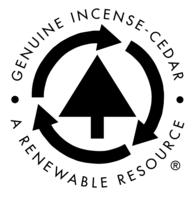
Note: This color pencil drawing of a California Incense-cedar tree comes from the cover of one of our California Cedar Products Company brochures dating to the early 1960’s. The artist is unknown.
This post is the first of a new series dealing with Incense-cedar, its historical and current use in the pencil industry; it’s conversion to pencil slats, finished pencils as well as other products; and important aspects of it’s growth and management as a timber resource in U.S. western forests.
Our company California Cedar Products Company founded in 1919 has had the unique position of playing a leading role of the development of California Incense-cedar (Libocedrus decurrens or also known as Calocedrus decurrens) as the premier wood species for high quality pencils worldwide. As alluded to in a recent post at the Pencil Revolution, Incense-cedar originally began to be used as a substitute wood for Eastern Red Cedar (Juniperus virginiana) which was the premier wood for US produced pencils and some European pencils dating from the mid 1800s through the early 20th century. It is commonly thought that the main purpose for the shift to Incense-cedar was due to dwindling supply of Eastern Red Cedar and there is some relevance here, but primarily from a comparative economic standpoint only. ERC is still widely used for commercial purposes today for products which most benefit from the technical characteristics contained in the natural cedar oil extractives of this species. Products such as closet lining, shoe trees, coat hangers, storage chests and natural oil extractives used in the essential oils industry for perfume and other cosmetic and scent purposes.
So what is the full story for the transition to Incense-cedar? First, western forests represented the largest unexploited wood basket in the United States and the superior growing conditions for softwoods and larger diameter of trees and increasing investment in western forest utilization during this period lead to the lowest cost of timber coming from the west. So from the first respect California Incense-cedar was less expensive than Eastern Red Cedar which was experiencing increasing prices as tree diameter sizes declined as increasing proportions of harvest came from second cut vs. “old growth” timber. However, economics of timber cost alone do not fully explain this transition. There were plenty of other species in the western US more plentiful and of lower cost to process, but none of these succeeded as a major pencil wood. In fact, even Incense-cedar pencil slats met initial resistance in the pencil industry and needed to be stained from it’s natural light blonde color to a deeper reddish-brown to match the accepted color of Eastern Red Cedar.
The real story lies in the technical properties of Incense-cedar which make it uniquely exceptional for use in pencils and various other applications. First, Incense-cedar exhibits optimal physical characteristics for close-tolerance, precision machining that make for very smooth machined surface and exceptional sharpenability in finished pencils as well as allowing optimal wood utilization from saw log, to pencil stock lumber, pencil slats and then into pencils. Additionally, it’s thermal conductivity rating or (K factor) is among the best for all softwoods. This provides dependable, predictable insulating properties and resistance to heat migration which positively impact performance of the species under machining conditions as well as gluing and drying.
As one of the most stable wood species Incense-cedar also stands up to wider variations in temperature and humidity without warping, checking or shrinking. This allows for tighter size tolerances and easy shipment to and use of cedar by pencil factories in many regions of the world where there are varying climates. Finally, the smoothly machined surface and relative lack of resin canals and pitch pockets assure that cedar pencils can be easily painted or stained with lacquer or water based stains to a fine, smooth finish without bleeding or other problems.
Beyond the timber economics and natural technical characteristics the final key factor in the success of Incense-cedar was the dedication and commitment of a small group of pencil slat manufacturers lead by CalCedar. This group focused their businesses uniquely on the production of high quality product, consistent and reliable supply and service, and technical development and leadership which increased yields and lowered total costs of production. By specialization just in production and sale of slats with a higher quality raw material coupled with continuous improvements in technology and finished product eventually most pencil companies eventually discontinued slat operations and began purchasing their slats from dedicated slat manufacturers. Pencil companies that had typically been vertically integrated with their own slat operations learned that they were able to improve their own business focus, finished pencil quality, operating economics and use of working capital by focusing solely on pencil production. In some cases the working capital and other economic savings were reallocated towards implementing production and supply of other writing instruments or complementary products to their distribution channels for pencils.
These were the major factors that lead to the leadership position of Incense-cedar as the premier pencil wood species in the world today. Of course times and market conditions change over time and there are several other wood species that have also become important in the  pencil industry these days. This topic will be addressed later in this series. However, my next post in this series will address information regarding growing conditions and forest management policies that assure that Incense-cedar remains a plentiful and well managed species assuring a sustainable long term supply for a wide range of uses.
pencil industry these days. This topic will be addressed later in this series. However, my next post in this series will address information regarding growing conditions and forest management policies that assure that Incense-cedar remains a plentiful and well managed species assuring a sustainable long term supply for a wide range of uses.
Remember to look for the Cedarmark which indicates use of Genuine Incense-cedar wood from California Cedar Products Company.


